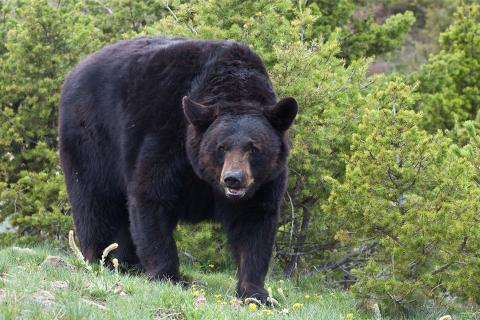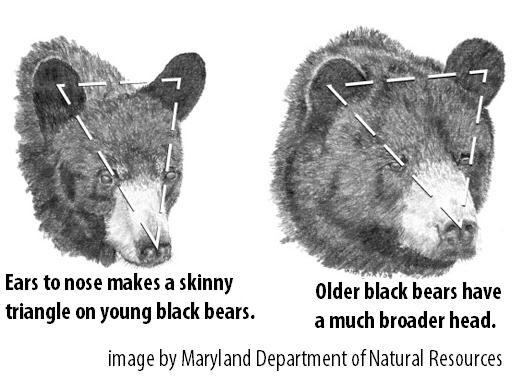
Whether you a hunt black bear in spring on a trip to a Canada or during fall in the U.S., black bears are among the most fascinating of all big game animals. Also, the black bear is pursued in various ways, from driving to glassing and stalking, still hunting to chasing with hounds, floating rivers to watching bait.

The pelt makes a great addition to any den or living room, and a bear shoulder mount on the wall is always a rich conversation piece. Plus, bear meat is delicious — like a combination of fatty beef and pork, but tastier than either of those domestic meats.
Tip: Best Smoked Bear Ham Recipe here
It's hard to match the incredible rush of intensity and life that overcomes you when you work hard for days and finally come into the shooting range of this hulking, shiny-furred beast that epitomizes so fully the wildness that is left in America today. And that, in the end, is the main reason why most of us pursue black bears.

To help you in that quest, here are some tips I've gleaned from over 30 years of black bear hunting with dozens of outfitters in over 20 states and provinces.
Choose the Right Cartridge Gun for Black Bear Depends on How You Hunt
Don't feel you have to invest in a new rifle just for a bear hunt. Most deer and elk guns will perform well on black bears. The 6mm and .243 are a bit on the light sight, but any caliber in the .270 class and up makes a good black bear weapon.
Standards such as the .308, .30-06, .280, .35, 7 mm Mag., .300 Mag, 338 and 6.5 Creedmoor all make excellent black bear guns. The .338 will also serve you well if you ever book a grizzly hunt in Canada. Bullets should range from 150-210 grains, with 165 and 180 particularly good weights for most calibers.
Check out the Ammo Shop at Bass Pro Shops or at Cabela's Ammo Shop here.
Tip: The Tikka T3X SuperLite Bolt-Action Rifle features a single stage adjustable trigger that breaks crisp and clean, allowing hunters to make quick, accurate shots under field conditions.
Tip: Shop all Tikka, Beretta and Sako rifles and rifle accessories here
 When trying to judge the age of a bear, look at its face. A big old boar has a wider, deeper face than young boars and females. His ears will look small compared to his body. They'll also appear to come out the side, rather than jutting up on top of the head.
When trying to judge the age of a bear, look at its face. A big old boar has a wider, deeper face than young boars and females. His ears will look small compared to his body. They'll also appear to come out the side, rather than jutting up on top of the head.
Tip See: 4 Ways to Judge the Size and Age of a Black Bear
The best period to hunt spring bears is from the last two weeks of April through mid-June. Weather can be a major influence, however, on the success or failure of a spring hunt during the earliest and latest few weeks of this period. If it's an unusually cold spring, mid and late April can be poor for bear hunting. If summer sets in early and it gets hot, the middle of June can be iffy. In general the entire month of May is the peak period for black bear hunting.
For a fall hunt, any time from September until the bears den up in January can be good. Generally, the best time during the day to hunt black bear is in the morning or early evening when they are searching for food
 If you're hunting in an area where baiting is legal, start well before the season putting food out to get bears used to coming to the site. Also, be sure to establish three or four bait stations so you'll be sure one or more is being hit when the season opens. If you have to clear shrubbery or branches to allow clean shooting lanes, do so several weeks before the season, so the animals will have time to get used to the changes.
If you're hunting in an area where baiting is legal, start well before the season putting food out to get bears used to coming to the site. Also, be sure to establish three or four bait stations so you'll be sure one or more is being hit when the season opens. If you have to clear shrubbery or branches to allow clean shooting lanes, do so several weeks before the season, so the animals will have time to get used to the changes.
A very effective way to hunt bears in the mountains of the West is to have two or three hunters hike to different ridges and then glass the slopes the other hunters are on. From the vantage point of an opposite ridge, you can often see bears that the person standing on that slope can't detect. Hand signals can then be used to direct that hunter to the bear's location. Set up a signal system for indicating the direction the bear is and what it's doing.
Hunt the prime foods to find bears. In the fall it may be acorns or corn. Bears love to walk in a couple of rows in a cornfield and then knock down the stalks and gorge themselves. An area with abundant acorns is also a hot spot if sign is present. In spring look for winter kill carcasses, skunk cabbage, berries, grasses, roots, insects and wildflowers such as trillium and glacier lily. Swamps, burns, logged areas and meadows are all prime spots to check out.
Hunt right to the end of legal shooting time. The biggest boars often roam right at the edge of darkness. Using the best optics you can afford will help you judge the quality of these late-roaming animals and place your shot with accuracy.
Learn to judge sign to tell how big a bear is. A scat pile the size of a Big Mac is from a little bear. Look for one almost as big as a loaf of bread to find a real brute. Also look at the front pad prints. Measure the width of the pad in inches, add 1-1 1/2 and convert to feet. You'll have a good indication of what the bear would square out at. For instances, a 5-inch pad would likely mean a 6-6 1/2 foot square bear-definitely a keeper.
Floating rivers is a fun and productive way to hunt black bears in the West and Canada. The boat takes you far from areas easily accessible by road and allows you to quietly ease downstream without spooking the quarry. Watch along the river banks where bears often cruise the shore looking for winter kill and fresh grasses to eat, but also glass on higher surrounding hills and mountain slopes.
Caution: Hunting or shooting is prohibited on many rivers and lakes in some states, always check state and federal regulations and laws before hunting or shooting on rivers, lakes and creeks.
Shoot across river. If you spot a bear on a float hunt it's tempting to pull the boat in below it and make a stalk upstream to the animal. A better bet in most cases is to pull into shore on the opposite side and shoot across the river. If you try the first method the bear will often leave before you can get to it or may be hard to spot in the thick cover.
Make sure the bear is dead. Bears are tough animals and difficult to track if you wound one because their long hair absorbs lots of blood, leaving little sign. If a bear goes down in sight, re-chamber a fresh load and be prepared to shoot again. If it moves, shoot a second time. A taxidermist can sew up an extra hole in the hide, but he can't bring your bear back if it gets up and runs off wounded after the first shot.
If you're hunting over bait, don't feel you have to shoot the first animal that comes in, unless you're sure it's a large mature boar. In prime areas it's not uncommon for several animals to use a single bait. Watch the bear. If he looks around and seems wary, a larger bear maybe in the area. Smaller bears often feed earlier in the evening. If a young bear comes in early, a larger one may well appear just before dark.
 When trailing hounds on a bear track, pay attention to the sound the dogs make. When the dogs' voices change from a steady bawl to a frantic "chop," that's a signal that the bear is treed or at bay. Move quickly to the hounds or the bear may climb down and escape.
When trailing hounds on a bear track, pay attention to the sound the dogs make. When the dogs' voices change from a steady bawl to a frantic "chop," that's a signal that the bear is treed or at bay. Move quickly to the hounds or the bear may climb down and escape.
Calling bears can be effective at times, particularly in western states and provinces. Calls can imitate either rabbits or fawn deer. When it works, calling brings in almost exclusively big, hungry boars that have killed before. To succeed with this technique, find a location with fresh sign indicating a medium to large bruin is in the area. Then position yourself on a rock or open area so you can see one coming before it gets right on top of you. Be ready. These bears may charge in to the call at a full gallop.
Where you place a bait is crucial for success. Good potential locations include areas near water, denning areas, the edge of woods near a grassy meadow or a spot with abundant fresh bear sign. Don't place baits out in the open, but rather at the edge of thick cover where the animal will feel more secure as he comes in to it. Always consider prevailing winds, too. If your human scent blows towards the bait from the stand location, it will be all but useless.
Bear meat is good for roasts, stews, steaks or ground up as hamburger. As with pork, there is a danger of trichinosis. Two percent of bears in a New York study carried trichinosis and up to 10 percent in a Montana survey. The trichina larvae are killed, however, by either freezing (5 degrees for 20 days, or -10 degrees for 10 days) or by cooking to a minimum internal temperature of 155 degrees.
There are so many tasty ways to prepare bear meat but, smoking a large bone-in bear ham takes the meat to the next level for taste. Click to print or download the Smoked Bear Ham Recipe
- 21883 views

